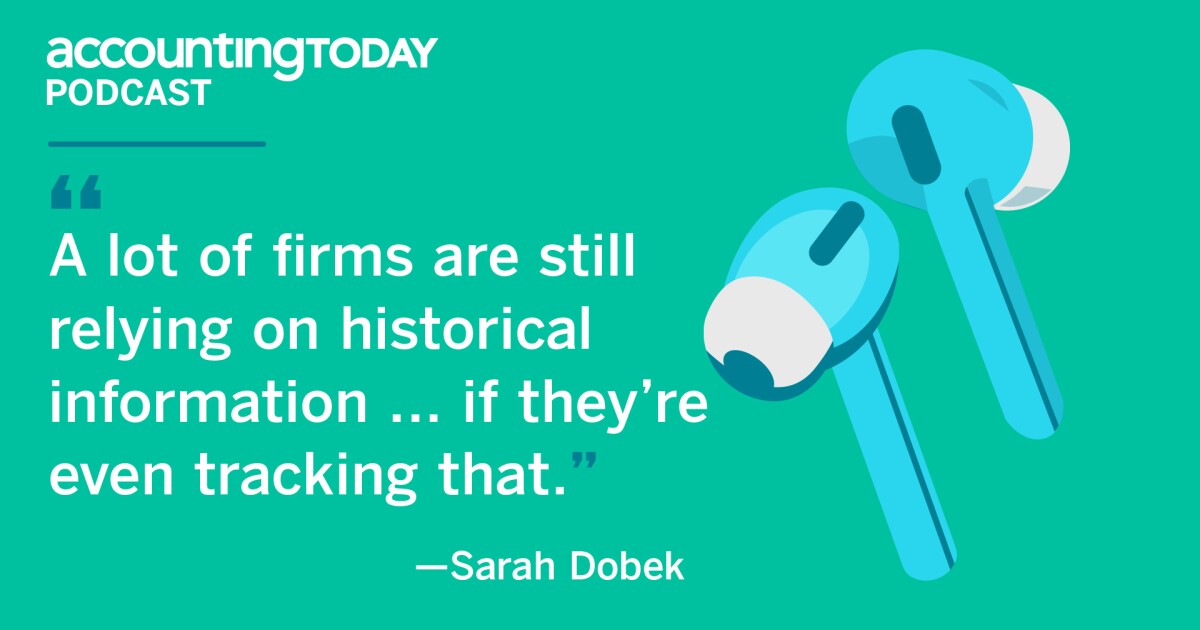Accounting
Crunching the right numbers | Accounting Today
Published
7 months agoon


Too many accounting firms are relying on outdated or inappropriate data to measure their success, and Sarah Dobek of Inovautus Consulting lays out a much more forward-looking set of data for them to work with.
Transcription:
Transcripts are generated using a combination of speech recognition software and human transcribers, and may contain errors. Please check the corresponding audio for the authoritative record.
Dan Hood (00:04):
Welcome to here with Accounting. Today, I’m editor-in-chief Dan Hood. How do you know if your firm is growing? Well, hopefully you’re measuring it — and you’re measuring the right things.
Here to talk about the key performance indicators that you should be looking at for growth is Sarah Dobek, the president and founder of Inovautus Consulting, a well-known consultant to accounting firms. Sarah, thanks for joining us.
Sarah Dobek (00:23):
Thanks Dan for having me.
Dan Hood (00:25):
Alright, well let’s just jump right in. Are they looking at the right KPIs, particularly for growth? There are other KPIs one might want to look at, but let’s talk specifically about the ones for growth. Are they looking at the right ones?
Sarah Dobek (00:35):
I think it depends on the firm. I would say that by and large, this is one of those things that firms evolve in. I think data has become much more important to accounting firms and the evolution of business intelligence, analytics and power bi. All of those things are enhancing this conversation, but I still think there’s a lot of room. So I think a lot of firms are still relying on historical information. What business did we close and where did our leads come from? If we’re even tracking that along with what I would call to be kind of historical and standard profitability metrics, like billable hours and realization. And I’m not going to say that those are wrong numbers. There’s a place for some of those numbers, but I think that if we’re looking at evaluating growth, there is a much larger spectrum of KPIs that firms should really be looking at today.
Dan Hood (01:31):
And it sounds like one of those things there is that they should be looking at current numbers as supposedly historical things. We’re talking more about a dashboard than about a report that you get out at the end of the month.
Sarah Dobek (01:41):
Yeah, I mean, absolutely. I mean, to some level, analytics are always going to be historical in nature, but if you can get them more real time, they become more valuable. I think part of the challenge is that we wait usually until the end of the year to look at our numbers, or many firms have historically done that or quarter end. And it’s hard to make changes when we start talking about growth if we don’t know where we’re going to be. And so being able to start to look at information that is more real time becomes really important. A question that we get all the time, we’re sitting in the middle of the year as we record this podcast. And a question I get, are we going to hit our numbers? Are we going to hit our growth goals for the year? And being able to answer that question is really important. Firm leadership because it impacts investments and staffing and so many other things. And so we can’t do that if we say, well, we got to wait till the end of the year and see what our billable numbers are at.
Dan Hood (02:38):
Yes, by that point it’s a little late. Well, let’s talk about, you’ve mentioned some of the numbers that might not be what they should be paying attention to. We’re not getting rid of them, we’re not throwing them out entirely. Know some of them maybe. But what are the numbers that on a daily basis you should be looking at going forward? You would just say you want to know now whether you’re going to be in a good shape to hit on third the quarter or the year. What should be looking on a day-to-day basis?
Sarah Dobek (03:06):
So let’s start with sales metrics. I think those are really important. When we start answering the question, are we going to hit our goals for the year? One of the places we start firms is understanding what’s going on in their sales process. And so that’s going to look like progress against our goals. And there’s a lot of places that we generate new revenue inside of the firm. And historically firms have looked at what new business has been brought in, but they can’t answer, is it business that’s going to happen this year is a business that’s going to happen next year? Which is a highly relevant question in any accounting profession because sometimes we’re closing tax work that we won’t begin until next year or an audit or something along those lines. The other is what’s the average deal size of what we’re closing to? What are our win rates look like?
(03:54):
Because those allow us to be able to start to forecast whether or not we’re going to hit our goals. And if we aren’t tracking a lot of this information and this data, it becomes really hard to answer that question. Usually in year one, we can’t very accurately predict whether we’re going to hit our goals, but if we know what our conversion rates are, if we have an idea of what all of this looks like, we have a better idea of confidently saying, yes, we are on track to hit that, or no, we aren’t on track to hit, that becomes important. The other is what’s happening with our marketing. Marketing plays a really important role in growth, and if we have a marketing function in the firm, they should be paying attention to what’s happening. If marketing is expected to do lead generation and we’re doing anything around inbound strategy, what does that lead qualification look like? What do our conversion rates look like? What’s happening with that information? And I will honestly say, Dan, that there’s a lot of firms that are not prepared for this. They’d either don’t have the software and the tracking mechanisms to be able to answer those questions or they’re not being expected to. The firms are managing their bandwidth and saying, we really just want to focus on referrals. They’re still a lot of accounting firms that sit primarily in that bucket, but those marketing metrics are as important. That leads into your sales pipeline.
Dan Hood (05:16):
Right?
Sarah Dobek (05:18):
Go ahead.
Dan Hood (05:19):
No, there’s so many things going on. We need a much longer, we need a to three day long podcast to talk about a lot of these things. But at some point I want to talk about different roles, KPIs, that different roles should be just touched on it there. Marketing, the marketing people, salespeople or business owner. The people will be looking at the pipeline in a way that, I mean that maybe the leadership of the firm is, right? They’re relying on the sales team, marketing team, biz team to tell them, Hey, our pipeline’s fine, or Oh no, our pipeline’s there or everyone, we’ve got enough people at enough of the stages that we need to be to know that they’re going to fill into the next number that maybe the leaders are looking at, which is new business. But Joel, well actually let’s go there. I mean, let’s talk about different levels of the firm. How different are the KPIs that different people at the firm are going to be looking at and that different levels of the firm are going to be looking at? Yeah,
Sarah Dobek (06:12):
That’s a great question. So I think that as a firm leader, we’re looking holistically at how the firm is tracking against their goals. And there’s a couple of important things that I would think that we want to look at it as a leader. One is, are we on track and are we growing? And what does that look like month over month? There can be a little bit of ebb and flow in public accounting around when billings go out and things like that, but we should be tracking up. We shouldn’t be far behind more than 30 days on some of our goals unless we know there’s a significant reason or there’s a deal out there. The other thing that I think is really important is what type of work are we bringing in? A big focus for firms in the last couple of years has been what is our average deal size and is that going up?
(07:02):
We really have to protect all this work firms have been doing to size their client bases. And so that’s a core metric and KPI that we look at across the board. And if that number is going down, huge red flag, that number should be going up. It should be staying somewhat consistent around the average size of the deals and even paying attention the granularity of that, which is who are we bringing into the firm? Is it aligned with our industry focus or size of firm that we’re looking for? And if it doesn’t, then we need to figure something out really quickly there and put a stop to that for some of those metrics. The other thing that we need to be looking at is our client retention. Attrition is a big factor in growth, and we’ve not paid enough attention to that. And there’s attrition for a lot of reasons.
(07:50):
There’s a ton of consolidation going on in the market, and I think that looking at the current client base and what that typically looks like, but also looking at m and a transactions, I just had this conversation with a client the other day, which is we have a lot of clients that are going through deals and we’re going to have to replace that revenue next year. And that is fairly significant revenue for this client. They’re all really good clients, but they have very high priced average size client relationships. And so that’s become a factor in our forecasting. And so part of the exercise that we take them through in the fall is anticipating out who’s told you they’re in the middle of a transaction or looking at a valuation. And while the firm can help leading up to that, and there’s some great dollars that they’ll do, they’ll get a little bit of work on the backend, but that relationship’s going to change and that’s going to go from maybe a client to a B or a C client, just if you’re purely looking at revenue.
Dan Hood (08:48):
So get as much out, at least you can,
(08:50):
But then get ready to know that. I mean, you hear different numbers, but generally people say somewhere between 10 and 15% of the average firm’s clients will turn it over in any given year. And as you said, there’s a lot of m and a going on, not just in the profession but outside it. That’s got to have an impact. A lot of business owners and clients are retiring. That’s all changes. What kind of services are going to need from each? So all things you need to be paying attention to, much more important than your average number of billable hours. For instance. There’s a couple of questions here about different KPIs that I wanted to get into. And one of them is, do you find that for firms at different stages of their growth, Guilford say a very small firm versus a firm that’s going from five to 10 million to 10 to $20 million, really making that big leap to a new sort of governance level, do you find that the KPIs are different for all of them or is it it’s pretty much the same kind of things as everybody needs to be paying attention to?
Sarah Dobek (09:48):
Yeah, we’re first growing something. It’s all about how are we getting in front of people? My age old for 23 years, I’ve been saying, people don’t know you exist. They can’t buy your services. It’s like having a business out there without a business sign. And I always joke with my clients, they’re the best kept in secret when they come to us. And our goal is not to make them the best kept in secret anymore. This isn’t a club that you get into and then you find out about what we do. And so on the early stage growth of any practice area or new service line, our goal is brand awareness. So we need to figure out how do we reach that brand awareness and what does market penetration look like? This is a term that accounting firms are like, excuse me, what? But it’s really like, how much of the market are we taking, right? We’re never going to own a hundred percent of a market
(10:39):
And what does that look like? And when we’re opening up, it’s a wide open field, but what does that look like and how are we bringing in clients and how are we getting in front of them? And so all of our metrics are about brand awareness typically. And then what does our client acquisition costs look like? Because usually investing heavily into that brand awareness, once we get into a growth stage, it’s more about scalability. We start looking at client retention numbers. We’re looking at average size of engagement. What does our operational piece look like? We need to make sure that we’re profitable and sometimes in early stage growth, we’re not yet profitable in the way that we want to be. How are we expanding in services? What does adoption of those services look like? And that’s when we tend to get into more of the sales metrics and the sales pipeline data is when we’re in a growth stage, and then when we’re mature, we’re looking back at market saturation and what our expansion strategy is, we’re typically bringing in a lot more innovation. And there’s not always as many metrics around that, but it’s more about market leadership and what are we doing? And oftentimes our pricing model changes. We’re in demand when we’re in more of a mature stage for that, and we’re really dialed into our profit margins and our industry recognition looks a lot different, our PR and publicity. So at each one of these stages and maturity level on our marketing, we’ll be looking at different metrics. And some of them are more important than others in some of these stages,
Dan Hood (12:16):
But you can definitely tie them into what stage you in terms of how well you’re known and where your clients are coming from and et cetera, et cetera. Absolutely. Yes. Very cool. Excellent. Alright, we’re going to take a quick break, but when we come back, I want to talk about some other KPIs that people might be looking at and how firms might be thinking about gathering all this information and then presenting it and make sure that the right people get it at the right times. But for now, like I said, we’re take a quick break.
(12:44):
Alright, and we’re back with Sarah Doak about consulting, talking about key performance indicators, particularly around growth. So far most of our focus has been on KPIs for growth and how you should measure them and the different measurements you’re going to make at different stages of your growth as a firm and your maturity as a firm. But I want to just take a step aside and say, are there other KPIs that you think firms should be looking at beyond just the ones related to growth or they’re the ones that you think are relevant that maybe they’re not paying as much attention to us, they should.
Sarah Dobek (13:12):
Yeah, so I think not necessarily, it doesn’t always translate into a number, but the answers we want to be able to, or the things we want to be able to answer related to marketing. So for our marketing leaders is what’s working and what’s not working. And this is a question leaders ask all the time. As we look at marketing budgets and we invest in things, and oftentimes our practice leaders don’t get involved other than asking the question. And as marketers and leaders in our marketing teams, we have to be able to address that, right? And we need to know what’s moving the needle and what’s not moving the needle because we all have limited resources. And this is a really hard thing in accounting firms, a lot of sacred cows. And part of our job as marketers is sometimes to unearth those sacred cows and it’s icky, sticky work that isn’t fun.
(14:03):
And quite honestly, it challenges people’s identity because we think we’re doing something really well. And then we come to find out there’s not really a return on that investment that we’re making on the sales side, our sales leaders and people, we have to be able to project and forecast what we’re doing to answer that question for our leaders. Are we going to hit our goals? And how are people performing and where are their issues? The biggest thing that sales data does is brings a line of sight for us on where we need to be working on things. We sometimes have this human perception that we’re doing better than we are, and unfortunately data has this way of bringing to light when we’re not doing that and it’s a benefit and a curse. And then the other is just for our larger leaders, the typical things that you would be looking at, but also how are we innovating? Innovation should be part of everything we’re doing, and I don’t have a magical number for innovation, but if we aren’t evolving our operations, if we are not figuring out how to use technology to do something, if we aren’t improving our infrastructure, if we aren’t doing a better job of delegating, man, that’s what I would be all over as a leader. And there’s not a magic number for that other than I would say it probably shows up in profitability and bandwidth resources.
Dan Hood (15:25):
Yeah. Well, I mean, yeah, I suppose to go back to the sales, the things you’re tracking about sales and new clients and so on. One thing you might be tracking is how many new engagements are for new services, how many new engagements are for new things you’re doing? What percentage of our businesses from stuff we were in offering last year, I always come back to three MI think has a number, something like 20 or some ridiculous percentage, 20 to 25% of their products needed to be new every year, which led to make a lot of total unnecessary products, but they worked for them. I’m not going to quibble, but so it’s fascinating because there is that to say it’s a difficult thing to measure that innovation. It’s also there’s all kinds of other KPIs people talk about in terms of mentoring and staff development and career development for your staff and recruiting, retention. That all could be sort of difficult to measure, but at least need to be born in mind
Sarah Dobek (16:19):
As we go forward. Well, my definition of innovation, Dan, is just a little bit different than maybe the rest of the markets. A lot of times we think of innovation as something that is brand new. I think of innovation as small baby steps towards refinement around what we’re doing. And so innovation could be something as simple. I remember when we rolled out our AI note taker, like what a game changer that was for our team to be able to shave off 10 or 15 minutes in handling recaps that we do for our clients and the detail that was needed. I can’t tell you how many times our team goes back to the notes that we use in our a I note taker from client meetings and how powerful that’s been for the work that we do. And to me, it wasn’t a large budget increase. It didn’t require a huge change in the process of what we do, but man, what an impact. And so I considered that an innovation when we rolled that out last year, and it’s been great. And so when we think about innovation, I want us to think about those small little things that impact our growth that can really make a big difference in our practice. And that can happen in a lot of sales and marketing in what we’re doing to grow our firms.
Dan Hood (17:33):
And as you say, very hard to measure, right? How do you measure if every task takes you 30 seconds less? How are you measuring that, right? And still it’s half the time you to spend, so Excellent. Well, let’s talk a little bit about all this information. One of the things people talk about routinely within accounting firms is the difficulty of getting information from one system to another. Or as we’ve talked about, the difficulty of actually putting numbers to a thing that you want to measure. There may be many KPIs that you want that are difficult to find within your systems if they can exist at all. How do you look at or who should be gathering all this information and how should it be being shared with the appropriate decision makers going to lead aside who the appropriate decision makers are? That’s a totally different discussion, but who should be gathering this information and how should they be sharing it?
Sarah Dobek (18:18):
It’s probably going to be a mix of people, Dan, inside of the firm, you’re going to be pulling on data that’s going to be coming out of the practice management system. So whoever in the firm is responsible or can be responsible for pulling the reporting data that’s needed out of there is important. There’s usually a big cleanup exercise that we watch firms go through when we start pulling metrics like this because we find a lot of data that just hasn’t been cleaned in a while or maintained in the way that it should have been. So we’re missing industry data, so we can’t segment by industry or our billing codes might be a mess. And that needs to be aligned so that we’re really clear what billing codes line up to tax or audit or cas to get the granularity that we want around the decisionmaking and the numbers that we’re looking for.
(19:03):
And so usually when we’re doing this, there’s some level of reporting coming from there. If we have a CRM system, a lot of the sales data is going to come out of the CRM system and in fact, that can be merged with some of the practice management data in some instances. And so dashboard reporting can be created. And then on the marketing side, all of it’s going to come out of the marketing technology that’s being used. And again, sometimes that links in with the sales data. If you’re on something like a HubSpot that has marketing automation and A CRM for firms that use different systems like a Salesforce or whatever, they have different plugins and software that will go along with those. So it’s going to come from a lot of different places. I think the key is to understand with each one of these functions, what do we need to know?
(19:46):
What are we looking at? And start with where you’re at. I have firms that we still use Excel spreadsheets for because we have stuff in constant contact and we’ve got stuff in Google Analytics and we have to bring that together. And I have firms that we have dashboards for that sit on a marketing automation platform. And so there’s no right or wrong other than to say, start with where you’re at, begin pulling what you can, and then eventually over time you’ll evolve it to where you want it to be. And we’ve got lots of firms that are building all those disparate resources into dashboards in their firms too when they’re kind of broken up, like tons of firms that have Power BI dashboards or Tableau where you name the branded software for it that are putting these types of things together.
Dan Hood (20:29):
I want to ask you one last quick question about that. Do you find generally speaking that that cleanup, the sort of massive cleanup that goes into getting the data is that most often, I think you think do it once and then you’re generally, you’re good going forward, as long as you maintain it properly? Or is it the kind of thing you’re doing every month or every week to do? I never say many different
Sarah Dobek (20:47):
Varieties. I encourage firms to learn from the cleanup process and put processes in place to maintain the data because if you are doing the dashboard reporting, like I talked about, whether that’s living in a CRM system or living in a BI system or whatever it looks like, I encourage there to be a process around it. And when firms are using that data, I often find that the management of the quality of data becomes easier because there’s a line of sight on where there’s discrepancies and when we have a line of sight, we can quickly fix it. The challenge with data in accounting firms is that we never had a line of sight. We didn’t know when data changed between one system and another, so we couldn’t update it. There was no notifications. We’d have to do these massive exports and match data. Dan, I can’t even tell you what I did early in my career and how many hours I spent matching accounting from data to get to some of these reports all summer. The first job that I worked in all summer, I spent doing this and today clicks of a button and it’s there. It’s amazing to
Dan Hood (21:46):
Me. Well, I mean, that’s one nice thing, right? Is the systems for doing this, for measuring these KPIs, for gathering them, for disseminating them, for being able to analyze them, they’re all getting better. Pretty costly, almost on a regular basis every week here about a new recording system with new capabilities. AI is obviously going to be making huge changes in here for all of us, but hopefully at the very least, it’ll get easier. It’ll certainly be more useful and more powerful. Very cool. Sarah Beck of Nevada Consulting, thank you so much for joining us.
Sarah Dobek (22:16):
All right, thanks, Dan for having me.
Dan Hood (22:18):
Thank you all for listening. This episode of On Air was produced by a Accounting Today with audio production by Wen-Wyst Jeanmary. Rate or review us on your favorite podcast platform and see the rest of our content on Accountingtoday.com. Thanks again to our guest and thank you for listening.
You may like
Accounting
Essential Strategies for Maintaining Data Security in Modern Bookkeeping
Published
4 hours agoon
May 10, 2025
In the modern world of digital finance, securing bookkeeping data is not just a good business habit—it’s absolutely essential. Bookkeepers work with confidential financial records, including income reports, payroll details, tax filings, and banking information. As cyber threats continue to evolve, protecting this data is a critical step in maintaining trust, ensuring compliance, and supporting business continuity. Let’s explore effective, easy-to-understand strategies that bookkeepers and businesses can use to strengthen their data security and avoid unnecessary financial risks.
Control Who Has Access to Financial Data
One of the first steps in keeping bookkeeping data secure is managing access control. Not every employee in a company needs access to financial information. Set permissions so that only those who absolutely need access—like bookkeepers, accountants, or certain managers—can see or edit sensitive records. This limits the chances of internal data leaks or accidental changes.
Use multi-factor authentication (MFA) for all financial software platforms. This adds an extra layer of protection beyond just a password. Even if a hacker steals someone’s login details, they can’t access the system without the second form of verification. Regularly conduct access reviews and audits to make sure permissions are current and appropriate.
Encrypt Data at All Times
Think of data encryption as the protective armor surrounding your financial files. Encryption converts information into unreadable code that can only be unlocked with a special key. Whether you’re storing records in the cloud, on a local device, or sending financial statements to clients, encryption ensures your data stays protected from cybercriminals.
For cloud-based accounting systems, make sure the provider offers end-to-end encryption and follows industry security standards. Also, be sure any email or messaging platform used to transmit bookkeeping data uses secure, encrypted connections.
Create a Reliable Backup Plan
Backing up bookkeeping data is a huge part of data security. A good rule to follow is the 3-2-1 backup strategy:
- Keep 3 copies of your data.
- Store them on 2 different media types (like a computer and an external hard drive).
- Keep 1 copy off-site, either physically or in the cloud.
This ensures that if your local systems are ever hacked, damaged, or lost due to hardware failure, your financial data is still safe and recoverable. Set up automated backup schedules to keep your backups current, and test the restoration process regularly to ensure you can access the data when needed.
Keep Accounting Software Up to Date
Outdated accounting software can become an open door for cybercriminals. Software providers release security updates and patches to fix bugs and defend against new threats. If you’re using software like QuickBooks, Xero, or Wave, enable automatic updates whenever possible. Check for updates weekly if you’re managing the process manually.
Always keep any antivirus and firewall systems active and updated. These tools act as your first line of defense against malware, ransomware, and other digital threats that could compromise your financial data.
Train Your Team on Data Security Best Practices
Technology alone can’t prevent security breaches. Human error is still the leading cause of many data security incidents. That’s why it’s important to train everyone involved in bookkeeping—even if it’s just a few team members—on cybersecurity basics.
Training should cover how to spot phishing emails, create strong and unique passwords, handle data responsibly, and respond to suspicious activity. Even quick, regular refresher sessions can greatly reduce your risk.
Keep a Clear Audit Trail
Document everything related to financial activity and data access. This includes who logs into your accounting systems, what changes they make, and when. Keeping an accurate audit trail helps you identify the source of any errors or breaches quickly. It’s also vital for regulatory compliance, especially if you undergo an audit by the IRS or other financial authority.
Choose bookkeeping software that includes activity logs and make sure they’re enabled. These logs can help you track down security problems before they get worse and provide evidence if something ever goes wrong.
Make Security an Ongoing Priority
Cybersecurity is not a one-time project. It’s a regular part of doing business in the digital age. As your business grows and technology changes, your approach to bookkeeping data security must evolve too. Review your data protection strategies quarterly, and update them to keep up with new threats and industry trends.
It’s also wise to stay informed about bookkeeping regulations, data privacy laws like GDPR or CCPA, and compliance requirements that apply to your business. The more proactive you are, the safer your financial records will be.
Data Security is the Foundation of Trust
Maintaining data security in bookkeeping is about more than just protecting your business—it’s about preserving your clients’ trust and your company’s reputation. From managing access controls and using encryption to updating software and training staff, each small step adds up to a stronger defense against potential threats.
When you make data protection a core part of your bookkeeping process, you reduce risks, improve accuracy, and ensure your business is always ready to face challenges. Remember, a secure bookkeeping system is the foundation of a successful, trustworthy, and future-ready business.
Accounting
AI great at simple tasks but struggles with complexity
Published
22 hours agoon
May 9, 2025
Artificial intelligence has indeed led tech-forward firms (including those in this year’s
On the positive end, firms such as the Texas-based Franklin Alliance reported that adopting AI technology has dramatically increased their capacities as bots take on repetitive manual tasks with an ease and a speed far past more conventional automation setups, allowing accountants to focus more on higher value tasks.
“What’s been most impressive about the AI tools we’ve explored is their ability to dramatically reduce the time spent on repetitive, manual tasks—things like document summarization, data extraction, and even early-stage tax prep. In the right context, these tools create real efficiency gains and allow our team to shift focus to higher-value advisory work,” said Benjamin Holloway, co-founder of Texas-based Franklin Alliance.

madedee – stock.adobe.com
For some, like Illinois-based Mowery & Schoenfeld, these efficiencies have been most impressive on the internal administration side, with AI effectively taking care of the non-accounting work that nonetheless keeps many firms afloat, especially where it concerns meetings.
“Truly most impressive and a huge time savings for us has been AI’s ability to record and summarize Team meetings. Circulating notes and reducing administrative burden on such activities has freed up much capacity, both for our admin side and for partners or management who are not able to be at every meeting,” said Chris Madden, director of information technology.
Others, like top 10 firm Grant Thornton, emphasized AI’s benefits in client-facing activities and noted that it has been especially meaningful in its risk advisory services at least partially due to the firm’s recently-launched CompliAI tool, designed specifically for this area.
“The tool uses generative artificial intelligence and was developed using Microsoft technology, including Microsoft Azure OpenAI Service. CompliAI’s ability to quickly analyze vast datasets and identify potential risks has proven invaluable in combining Grant Thornton’s extensive global controls library with generative AI models and features, including AI analysis, ranking and natural language processing capabilities. As a result, our employees can run control design and assessment tasks in minutes, versus days or weeks. This means clients enjoy faster operational insights, which could amount to a new level of efficiency and a path toward transformative growth,” said Mike Kempke, GT’s chief information officer.
Another positive frequently mentioned, such as by top 25 firm Cherry Bekaert, has been the accessibility and ease of use for many AI solutions even for those without strong technical capacities. Assurance partner Jonathan Kraftchick said this means they did not need to wait long before they began seeing results.
“The most impressive aspect of AI has been its ability to add value with minimal ramp-up time. Many of the tools we’ve implemented have a low barrier to entry, allowing users to start experimenting and seeing results almost immediately. Whether it’s drafting content, conducting accounting research, summarizing meetings, normalizing data, or detecting anomalies, AI has consistently helped accelerate tasks and enable our teams to focus on higher-risk or higher-value areas,” he said.
Several firms, such as California-based Navolio & Tallman, also mentioned improvements to broad strategy and ideation, saying it’s been good for enhancing creativity and accelerating the early stages of their work.
“We’ve still seen value in AI as a jumping off point for ideas and strategy. It’s been helpful for brainstorming, drafting early versions of client communications, and supporting high-level planning conversations,” said IT partner Stephanie Ringrose.
Inconsistencies, inaccuracies, insufficiency, and insecurity
At the same time, firms over and over again said that while the strength of AI comes in handling simple jobs, it often lacks the precision and consistent accuracy needed for higher value accounting work. While it can certainly generate outputs at an industrial scale, trusting that those outputs are correct is another story for firms like Community CPA and Associates.
“AI is incredibly useful for certain types of tasks, such as summarization, data extraction, answering simple questions, drafting communications or documentation, brainstorming ideas, or serving as a sounding board. However, we have observed that most AI tools we’ve tried have difficulty with complex tasks that require lots of context, precision, or domain-specific knowledge. Oftentimes in these cases, AI tools will generate responses that are overly confident or wrong and are missing key information due to not being integrated with other systems or software we have,” said CEO Ying Sa.
Some, like top 25 firm Armanino, noted that these challenges mean that humans need to devote considerable time to ensuring the quality of AI outputs and intervening when the programs go off track.
“The primary disappointment stems from the occasional inaccuracies or biases inherent in AI-generated outputs, commonly referred to as ‘hallucinations,’ necessitating continuous human oversight to ensure reliability. Addressing these inconsistencies remains an ongoing challenge,” said Jim Nagata, senior director of cybersecurity and IT operations.
Top 25 firm Eisner Amper’s chief technology officer Sanjay Desai noted that these issues with accuracy and consistency can be found across AI solutions, though noted that the technology is still quite new and so many things are still in the process of being refined.
“The lows come from the gap between what’s possible and what works reliably in practice. We still need strong guardrails to define valid inputs and outputs, especially in sensitive use cases. Technologies like retrieval augmented generation (RAG) haven’t yet delivered the accuracy or consistency we need when working with proprietary or domain-specific data. Even in mature areas like audio-to-text transcription, we see issues—particularly with accurately identifying speakers in multi-person meetings, which affects the quality of recaps and follow-up actions. In short, while LLMs have come a long way, making them enterprise-ready still requires ongoing human oversight, thoughtful implementation, and continuous refinement,” said Desai.
Another issue reported by several firms was what firms like Navolio & Tallman saw as ongoing security risks from AI solutions that limits their ability to apply the technology to more sensitive use cases.
“The overall attention to security and privacy is still more limited than our industry requires, vendors have not yet aligned their pricing models with the impact their tools make to the business, and vendors still oversell their AI capabilities,” she said.
Top 25 firm Citrin Cooperman also noted–among other things–that the security of these solutions could stand to improve.
“The overall attention to security and privacy is still more limited than our industry requires, vendors have not yet aligned their pricing models with the impact their tools make to the business, and vendors still oversell their AI capabilities,” said chief information officer Kimberly Paul.
Another issue with AI that firms have reported is that solutions today don’t seem to integrate especially well with other programs, which limits the ability of these solutions to work across multiple systems in a single coherent workflow–under such conditions, AI solutions can wind up being siloed from the very areas it is needed the most.
“We believe one of the biggest gaps in current AI solutions is the inability to integrate into other AI solutions to work collectively across one process or workflow. There are many cases where one AI solution is very good at a specific task, while another is very good at another process or task, but the gap is the ability to integrate those solutions together to solve for an entirety of a process or a workflow,” said Brent McDaniel, chief digital officer for top 25 firm Aprio.
There is also the matter of data integration, which is needed for AI systems to gain a more holistic understanding of a firm’s needs. Without such integrations, AI becomes more limited in its ability to develop insights and provide actionable guidance, according to Tom Hasard, IT shareholder for New Jersey-based Wilken Gutenplan.
“We wish AI tools could fully synthesize all of our internal data and unique expertise—beyond the scope of general internet search—and provide detailed, context-specific answers for our team. In the near term, we envision an internal system that taps into our accumulated knowledge to assist staff in resolving complex client problems more quickly. Over time, this capability could be extended to give clients direct, on-demand access to our specialized insights, effectively scaling our expertise and delivering value in a more immediate and personalized way,” he said.
Beyond just data, lack of integration also limits the ability for AI to address complex problems due to lack of cross-disciplinary expertise, according to Kempke from Grant Thornton.
“Current AI solutions lack the deep cross-disciplinary expertise to be able to solve complex issues. AI today is optimized for specific fields and tasks but when it comes to solving problems that span multiple disciplines such as Tax, Legal and Finance, the current solutions are not yet capable of providing meaningful advice and guidance. Grant Thornton is already working with various AI partners on this issue and targets to be a very early adopter of the next iteration of AI that addresses this,” he said.
The AI wishlist
Many firms hoped that the next generation of AI solutions would address these sorts of problems in a way that will allow them to become true assistants capable of taking on complex tasks that require extensive judgment.
“We have found that AI currently lacks in the ability to replicate human creativity and complex decision-making. While AI excels at data analysis and task automation, it struggles with tasks requiring creativity and nuanced judgment. If AI could offer more sophisticated support in areas such as accounting and audit services, its value and impact in our daily lives would be significantly enhanced,” said Jim Meade, CEO of top 50 firm LBMC.
Desai, from Eisner Amper, also pointed out that AI isn’t very good at handling bad data, which is a problem considering that AIs run on data. This means that using AI effectively today still requires a great deal of data processing and sanitation to make information useful. If humans did not need to do so much manual cleanup to get data AI-ready, it would help make the technology even more efficient.
“One of the biggest gaps in AI today is its limited ability to handle bad data. Since data is the foundation of any AI strategy, it’s a challenge that most organizations still face— dealing with messy, inconsistent, or unstructured data. We wish AI could do more to identify, fix, and improve data quality automatically, instead of relying so much on manual cleanup,” said Desai.
Finally, Avani Desai, CEO of top 50 firm Schellman, said that AI needs to not only be safer, it needs to be visibly so, as trust and confidence in the technology is often key to adoption.
“I wish that AI could de-risk itself so that clients would be more open to using it and build client trust. If AI could more clearly demonstrate safety and responsible use, adoption would be much easier. Once people understand it’s here to help—and learn to use it responsibly—the fear will fade,” she said.


Representative Nicole Malliotakis said increasing the state and local tax deduction cap to $30,000 from $10,000 would reduce the tax burden of the vast majority of people in her district, indicating support for a proposal that is dividing Republicans.
“Every member needs to advocate for the particular needs of their district. Tripling the deduction to $30,000 will provide much-needed relief for the middle-class and cover 98% of the families in my district,” Malliotakis, a Republican representing Staten Island, New York and a member of the House tax committee, said in a statement to Bloomberg News on Friday.
Malliotakis’ nod of approval for a $30,000 SALT deduction cap comes as Republicans are fighting among themselves about how high to increase a tax break that has the potential to scuttle President Donald Trump’s entire tax package.
House Speaker Mike Johnson on Thursday said the $30,000 write-off limit is one of several options being discussed. That figure was rejected by several other New York Republicans, including Elise Stefanik, Nick LaLota, Mike Lawler and Andrew Garbarino. California’s Young Kim also rebuffed the idea.
Malliotakis’ district has less expensive property values and lower incomes than some of the other lawmakers pushing for a SALT expansion, making it politically viable for her to accept a lower cap than some of her colleagues.
White House Press Secretary Karoline Leavitt suggested on Friday that Trump would not weigh in on an appropriate level for a SALT cap, leaving it to lawmakers to resolve.
“There’s a lot of disagreement on Capitol Hill right now about the SALT tax proposal, and we will let them work it out,” she told reporters.
House Republicans’ narrow majority means that Johnson needs to win the support of nearly all his members to pass Trump’s tax-and-spending package.
Several of the SALT advocates have said that they are willing to block the bill unless there is a sufficient increase to the deduction. However, most members have not publicly stated how high the deduction must be to win their support.
The debate over SALT has proved to be a particularly thorny fight because it is a political priority for a small but vocal group of Republicans representing swing districts critical to the party maintaining a majority in the 2026 midterm elections.
Expanding the write-off is an expensive proposition, and Republicans have little fiscal wiggle room as they are sparring over ways — including cuts to Medicaid and levy hikes on millionaires — to offset the cost of the tax-cut package.
The House Ways and Means Committee is slated to consider the tax portion of the bill on Tuesday, including SALT changes.

Essential Strategies for Maintaining Data Security in Modern Bookkeeping

Investor Ric Edelman reacts to crypto ETF boom

The key issues and who stands to benefit

New 2023 K-1 instructions stir the CAMT pot for partnerships and corporations

The Essential Practice of Bank and Credit Card Statement Reconciliation

Are American progressives making themselves sad?
Trending
-

 Finance1 week ago
Finance1 week agoWarren Buffett to ask board to make Greg Abel CEO of Berkshire Hathaway at year-end
-

 Finance1 week ago
Finance1 week agoBerkshire meeting ‘bazaar’ features Buffett Squishmallows, 60th anniversary book and giant claw machine
-

 Personal Finance1 week ago
Personal Finance1 week agoMillions of older workers lost jobs during Covid. Prospects have improved
-

 Economics1 week ago
Economics1 week agoWhy does America have birthright citizenship?
-

 Economics1 week ago
Economics1 week agoHow Donald Trump could rescue John Roberts
-

 Economics1 week ago
Economics1 week agoJobs report Friday to provide important clues on where the economy is heading
-

 Economics1 week ago
Economics1 week agoHow one Ivy League university avoided the president’s wrath
-

 Accounting7 days ago
Accounting7 days agoThe Importance of Backing Up Bookkeeping Data
